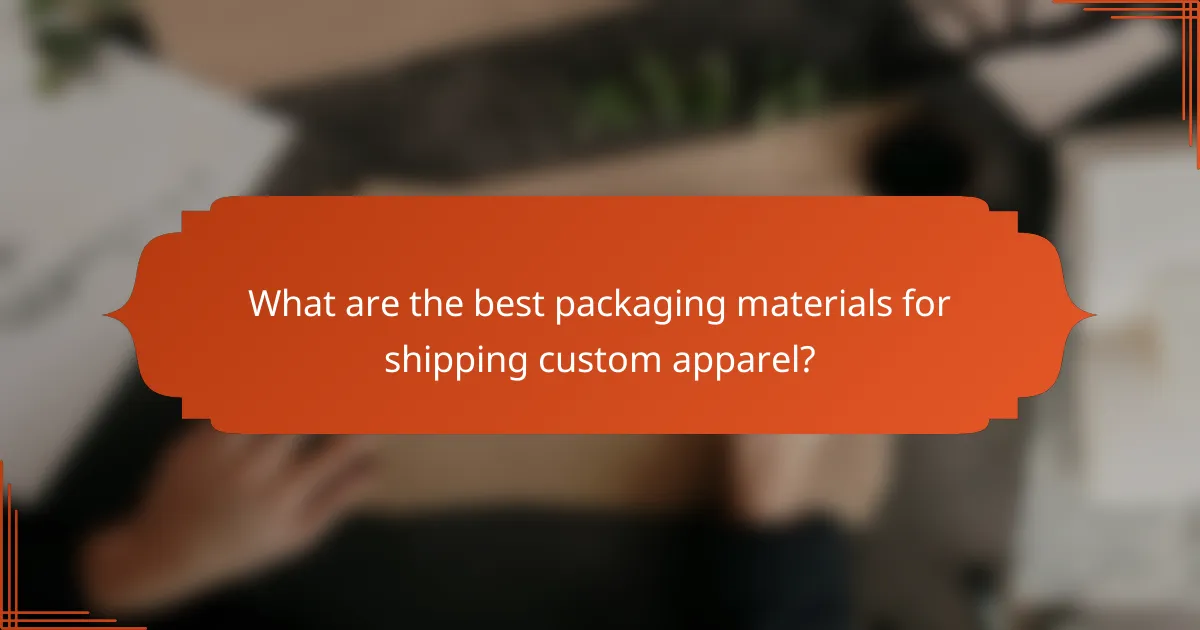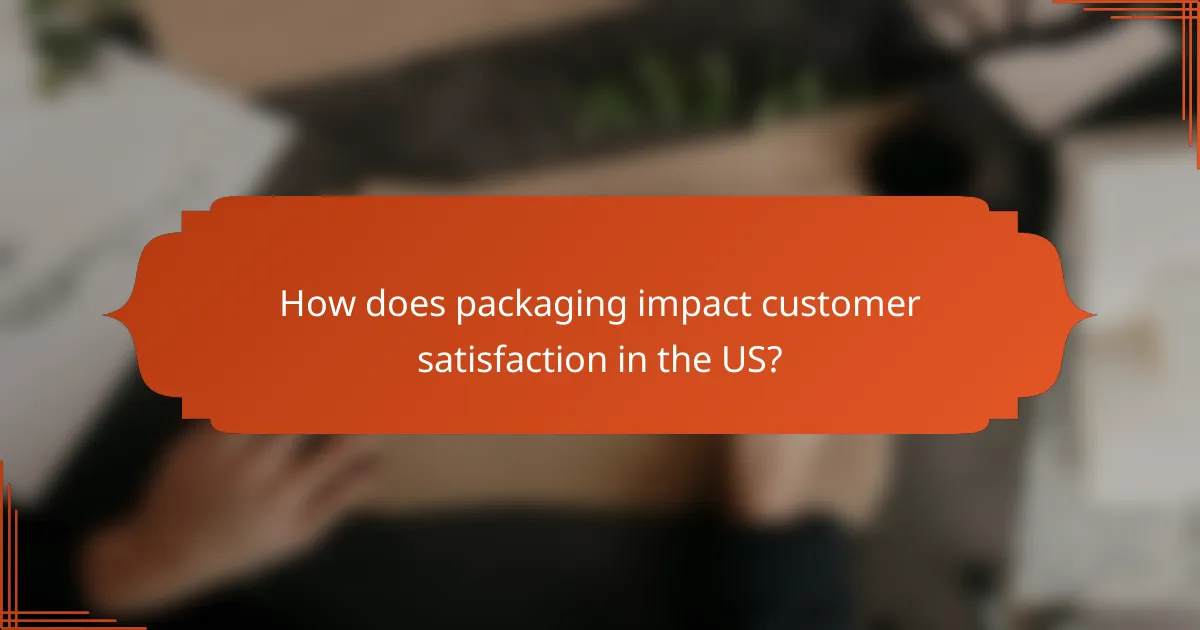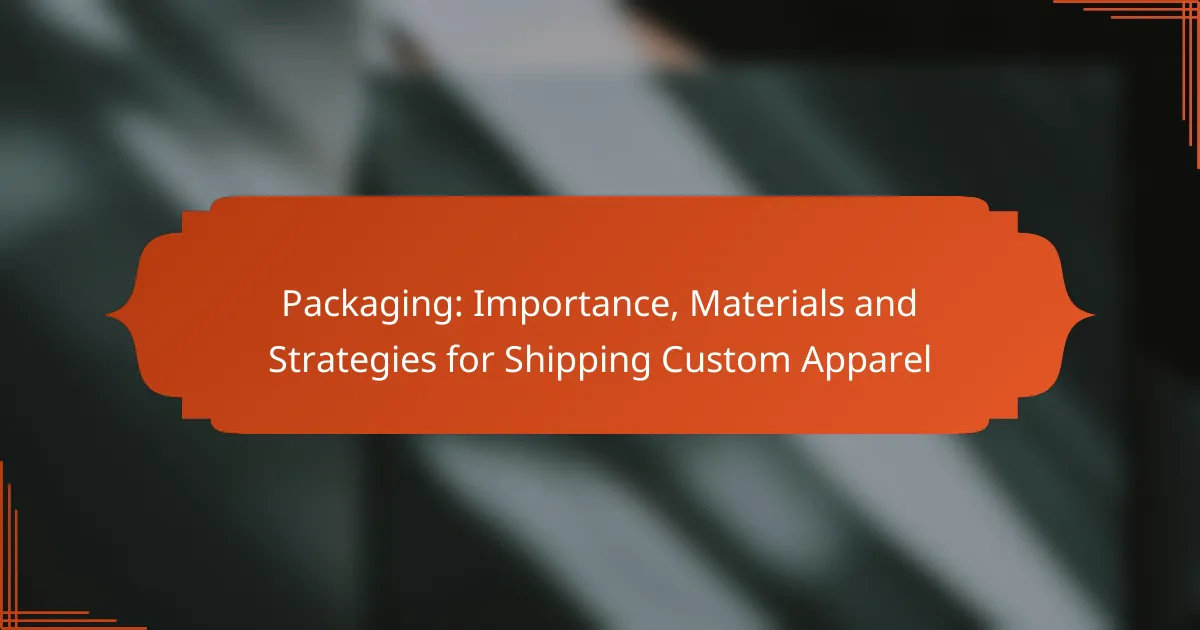Packaging plays a crucial role in the shipping of custom apparel, impacting both product protection and customer satisfaction. By selecting the right materials, such as poly mailers or biodegradable options, businesses can enhance the unboxing experience while ensuring items arrive in pristine condition. Additionally, employing effective shipping strategies can streamline the process and foster customer loyalty.

What are the best packaging materials for shipping custom apparel?
The best packaging materials for shipping custom apparel include poly mailers, cardboard boxes, biodegradable options, bubble wrap, and custom branded packaging. Each type offers unique benefits and considerations that can enhance the protection and presentation of your apparel during transit.
Poly mailers
Poly mailers are lightweight, waterproof, and cost-effective, making them a popular choice for shipping custom apparel. They are ideal for clothing items that are not fragile and can be easily folded, helping to reduce shipping costs.
When using poly mailers, ensure they are of good quality to prevent tearing during transit. Consider using opaque mailers to maintain privacy and enhance the unboxing experience for customers.
Cardboard boxes
Cardboard boxes provide excellent protection for custom apparel, especially for bulk orders or items that require extra cushioning. They are sturdy and can be reused or recycled, aligning with sustainable practices.
Choose the right size box to minimize movement inside during shipping. Adding packing materials, such as crumpled paper or air pillows, can further protect the contents from damage.
Biodegradable options
Biodegradable packaging materials are an eco-friendly alternative that appeals to environmentally conscious consumers. These materials break down naturally, reducing landfill waste and environmental impact.
Look for options made from plant-based materials or recycled paper. While they may be slightly more expensive, they can enhance your brand’s image and attract customers who prioritize sustainability.
Bubble wrap
Bubble wrap is an effective cushioning material for fragile items or accessories that accompany custom apparel. It provides shock absorption and protection against impacts during shipping.
When using bubble wrap, ensure that it is securely wrapped around the items and sealed properly. This will help prevent any movement and potential damage during transit.
Custom branded packaging
Custom branded packaging enhances brand recognition and creates a memorable unboxing experience for customers. This can include printed boxes, tape, or mailers featuring your logo and design elements.
Investing in custom packaging can increase perceived value and customer satisfaction. However, balance the cost with your budget and ensure that the packaging remains functional and protective for the apparel being shipped.

How does packaging impact customer satisfaction in the US?
Packaging significantly influences customer satisfaction in the US by shaping their initial perceptions and protecting the product during shipping. Effective packaging not only enhances the unboxing experience but also ensures that items arrive in excellent condition, fostering trust and loyalty among consumers.
First impressions matter
The first impression a customer has of a product often comes from its packaging. Well-designed packaging can convey quality and attention to detail, making customers feel valued. For custom apparel, using branded boxes or bags that reflect the brand’s identity can enhance this initial perception.
Consider incorporating vibrant colors, unique shapes, or eco-friendly materials to stand out. Aesthetically pleasing packaging can lead to higher customer expectations and satisfaction, which can translate into repeat purchases.
Protection during transit
Proper packaging is essential for protecting custom apparel during transit. This includes selecting materials that can withstand various shipping conditions, such as moisture and rough handling. Using padded envelopes or sturdy boxes can help prevent damage to garments.
Additionally, consider using biodegradable packing peanuts or air pillows to fill empty spaces and reduce movement inside the package. This extra layer of protection can significantly decrease the likelihood of returns due to damage, ultimately improving customer satisfaction.
Unboxing experience
The unboxing experience plays a crucial role in customer satisfaction. A thoughtfully packaged product can create excitement and anticipation, enhancing the overall perception of the brand. Including personalized notes or small freebies can elevate this experience further.
Brands should aim to create a memorable unboxing experience by using high-quality materials and unique designs. Simple touches, such as custom tissue paper or branded stickers, can leave a lasting impression and encourage customers to share their experience on social media, amplifying brand visibility.

What are effective strategies for shipping custom apparel?
Effective strategies for shipping custom apparel focus on cost efficiency, speed, and customer satisfaction. Implementing flat rate shipping, establishing free shipping thresholds, and exploring international shipping options can enhance your shipping process and improve overall customer experience.
Flat rate shipping
Flat rate shipping simplifies the cost structure for both businesses and customers. By charging a fixed fee regardless of weight or distance, it allows for predictable shipping expenses. This approach can be particularly beneficial for small to medium-sized businesses, as it encourages customers to order more items without worrying about escalating shipping costs.
When considering flat rate options, evaluate the shipping carriers that offer this service, such as USPS, UPS, or FedEx. Each may have different pricing tiers based on package size and destination, so compare these to find the best fit for your business needs.
Free shipping thresholds
Setting a minimum purchase amount for free shipping can incentivize customers to buy more. For example, offering free shipping on orders over $50 can effectively increase average order values. This strategy not only enhances customer satisfaction but also helps cover shipping costs through increased sales.
To implement this, analyze your profit margins and shipping expenses to determine a threshold that works for your business. Monitor customer behavior to adjust the threshold as needed, ensuring it remains attractive while still profitable.
International shipping options
Offering international shipping expands your market reach and can significantly boost sales. Consider partnering with carriers that specialize in international logistics, such as DHL or FedEx, to navigate customs and duties efficiently. Providing clear information about shipping times and potential fees can enhance customer trust and satisfaction.
When shipping internationally, be aware of regulations and restrictions for different countries. Researching these can prevent delays and ensure compliance. Additionally, consider using a shipping calculator on your website to provide customers with accurate shipping costs based on their location.

What criteria should you consider when choosing packaging for custom apparel?
When selecting packaging for custom apparel, consider factors such as cost, size, weight, and branding potential. These criteria directly impact shipping efficiency, customer experience, and overall brand perception.
Cost-effectiveness
Cost-effectiveness is crucial when choosing packaging for custom apparel. Evaluate the total costs, including materials, shipping, and potential returns. Opt for packaging that balances quality and price to avoid overspending while ensuring protection during transit.
Consider bulk purchasing options to reduce per-unit costs. Many suppliers offer discounts for larger orders, which can significantly lower your overall packaging expenses.
Size and weight
The size and weight of your packaging directly affect shipping costs and logistics. Choose packaging that fits your apparel snugly to minimize excess weight and volume. This not only reduces shipping fees but also decreases the environmental impact.
Utilize lightweight materials that still provide adequate protection. For example, poly mailers are often a good choice for clothing, as they are lighter than boxes and can be customized to fit various apparel sizes.
Branding opportunities
Packaging serves as a powerful branding tool for custom apparel. Use it to convey your brand identity through colors, logos, and messaging. Well-designed packaging can enhance the unboxing experience and leave a lasting impression on customers.
Consider adding personalized elements, such as thank-you notes or branded stickers, to create a more engaging experience. These small touches can foster customer loyalty and encourage repeat purchases.

How can you optimize packaging for e-commerce in the apparel industry?
Optimizing packaging for e-commerce in the apparel industry involves selecting the right materials and strategies that protect products while enhancing the customer experience. Effective packaging not only reduces shipping costs but also minimizes environmental impact and improves brand perception.
Choosing the Right Materials
Selecting appropriate packaging materials is crucial for protecting apparel during transit. Common options include poly mailers, cardboard boxes, and biodegradable materials. Poly mailers are lightweight and cost-effective, while cardboard boxes offer better protection for fragile items.
Consider using recycled or eco-friendly materials to appeal to environmentally conscious consumers. This choice can enhance your brand’s reputation and potentially justify a premium price point. Always ensure that the materials used are suitable for the type of apparel being shipped.
Designing for Customer Experience
Packaging should not only protect the product but also create a memorable unboxing experience. Custom-branded boxes or mailers can enhance brand recognition and customer satisfaction. Including a thank-you note or promotional material can further engage customers and encourage repeat purchases.
Keep in mind that the first impression matters. A well-designed package can make customers feel valued and appreciated, which can lead to positive reviews and word-of-mouth referrals.
Cost-Effective Shipping Strategies
To optimize shipping costs, consider using flat-rate shipping options or negotiating bulk shipping rates with carriers. Evaluate the weight and dimensions of your packages to ensure you are not overpaying for shipping. Lightweight materials can significantly reduce shipping costs.
Implementing a shipping strategy that includes regional distribution centers can also minimize delivery times and costs. This approach allows you to ship products from locations closer to your customers, improving efficiency and customer satisfaction.
Minimizing Environmental Impact
Reducing the environmental impact of packaging is increasingly important to consumers. Use recyclable or compostable materials whenever possible, and consider implementing a take-back program for used packaging. This not only reduces waste but also fosters customer loyalty.
Additionally, aim to minimize excess packaging. Streamlining your packaging process can reduce material waste and shipping costs, aligning your business with sustainable practices that resonate with today’s eco-conscious shoppers.
